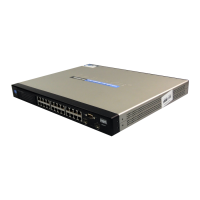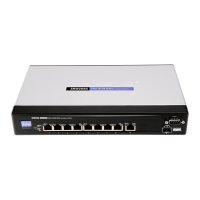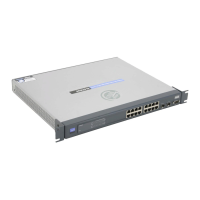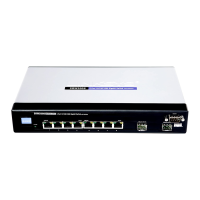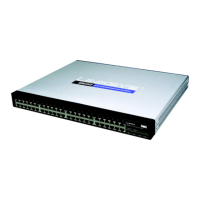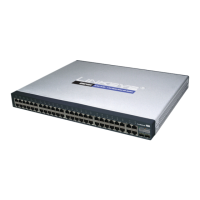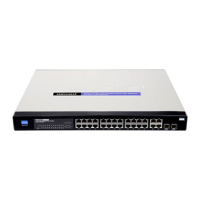Do you have a question about the Linksys SRW2024 and is the answer not in the manual?
Introduction to the Linksys 16/24-Port Gigabit Switch and its user guide.
Overview of the content and structure of the user guide.
Describes differences between 16 and 24-port models and general form.
Details LEDs (SYSTEM, Link/Act, Gigabit) and RJ-45 ports on the front.
Describes the power port and mini-GBIC/Console ports on the rear of the switch.
Explains how to connect network devices to the switch with a diagram.
Guidelines for choosing a location and preparing for installation.
Instructions for desktop and rack-mount placement of the switch.
Step-by-step instructions for mounting the switch in a standard rack.
Detailed steps for connecting devices, power, and console cable.
Introduction to the menu-driven console interface for configuration.
Steps to set up HyperTerminal on a PC for switch console access.
Navigating the console menus and understanding available actions.
Details the options available in the main console menu.
Lists the options for configuring system settings.
Viewing firmware versions and general system details.
Displays description, up time, MAC, contact, name, and location.
Options for Serial Port or Telnet configuration.
Setting the baud rate, data bits, parity, stop bits, and flow control.
Configuring the Telnet session timeout.
Accessing IP Address Settings, HTTP, and Network Configuration.
Setting IP address, subnet mask, default gateway, and DHCP status.
Configuring the HTTP server status and port number.
Offers Ping and TraceRoute network tests.
Performing and viewing results of a ping test to an IP address.
Performing and viewing results of a traceroute test to an IP address.
Uploading or downloading configuration, boot, or image files.
Restoring the switch to its factory default settings.
Restarting the switch.
Displays port numbers, link status, speed, duplex, and flow control.
Configuring port settings like auto-negotiation, speed, duplex, and flow control.
Provides context-sensitive help information for console interface navigation.
Describes the web-based utility for switch configuration.
Steps to access the switch's web interface via a browser.
Entering general information like model name, system name, and location.
Enabling or disabling the Jumbo Frames feature for faster data transmission.
Defining the aging interval for the forwarding database and viewing VLAN entries.
Configuring system clock settings via SNTP, local time, and daylight saving.
Assigning DHCP or static IP settings, default gateways, and hostnames.
Viewing and configuring port settings like speed, duplex, and auto-negotiation.
Detailed explanation of port parameters: Admin Status, Speed, Duplex, MDI/MDIX, Storm Control.
Creating and managing VLAN groups for LAN segmentation.
Managing ports within a VLAN, setting PVID and acceptable frame types.
Configuring Link Aggregation Groups (LAGs) to increase bandwidth and redundancy.
Configuring port mirroring for diagnostics and debugging network traffic.
Enabling Link Aggregation Control Protocol (LACP) on relevant links for LAGs.
Implementing priority queuing using Class of Service (CoS) and methods like Strict Priority.
Selecting CoS methods and assigning bandwidth values for traffic queues.
Assigning CoS settings to traffic queues based on priority tag values.
Configuring Access Control Lists (ACL) to manage network access profiles.
Enabling port-based authentication and specifying authentication methods.
Configuring 802.1x authentication settings per port using RADIUS and EAP.
Details on TX Period, Supplicant Timeout, Server Timeout, Max Request, Reauthentication.
Assigning authentication profiles to management methods (HTTP, Local, RADIUS, TACACS+).
Configuring RADIUS server settings for authentication (IP, priority, port, retries).
Details on RADIUS server IP, priority, port, retries, timeouts, and key strings.
Configuring TACACS+ server settings for authentication and authorization.
Details on TACACS+ server IP, priority, port, timeouts, and single connection.
Enabling/disabling Storm Control to limit multicast and broadcast frames.
Viewing users authenticated and permitted on each port.
Setting a password for system access to the switch.
Configuring SNTP server polling and update settings for time synchronization.
Managing encryption keys to authenticate SNTP sessions.
Viewing and configuring unicast, anycast, and broadcast SNTP server settings.
Configuring SNTP settings for specific interfaces (port, LAG, or VLAN).
Displaying received and transmitted packet statistics for interfaces.
Showing interface statistics related to FCS errors, collisions, and MAC transmit errors.
Displaying switch usage and error statistics using RMON (Remote Monitoring).
Configuring RMON history entries for data sampling from ports.
Viewing interface-specific statistics from network sampling entries.
Configuring and monitoring network alarms based on rising/falling thresholds.
Configuring RMON events and their descriptions, types, and communities.
Displaying a list of configured RMON events with log numbers and times.
Displaying EAP packet statistics for a specific port.
Viewing information about log entries saved to the flash memory Message Log.
Displaying all system logs saved in RAM in chronological order.
Defining which events are recorded by logs and setting logging parameters.
Connecting to the switch via Telnet for terminal emulation.
Resetting the switch to its factory default configuration.
Downloading firmware or configuration files to the switch.
Uploading firmware or configuration files from the switch to a TFTP server.
Restoring the switch's factory defaults and noting current settings.
Performing performance tests on copper cables and viewing results.
Downloading files to the switch via HTTP.
Accessing help information for the Web-based Utility screens.
Overview of Gigabit Ethernet speeds and integration with existing networks.
Explanation of fiber optic cabling types, connectors, and usage.
Enabling TCP/IP for network communication and wireless networking.
Instructions on sharing printers, folders, or files over the network.
Instructions on adding PCs to your network via Network Neighborhood.
Introduction to the Linksys 16/24-Port Gigabit Switch and its user guide.
Overview of the content and structure of the user guide.
Describes differences between 16 and 24-port models and general form.
Details LEDs (SYSTEM, Link/Act, Gigabit) and RJ-45 ports on the front.
Describes the power port and mini-GBIC/Console ports on the rear of the switch.
Explains how to connect network devices to the switch with a diagram.
Guidelines for choosing a location and preparing for installation.
Instructions for desktop and rack-mount placement of the switch.
Step-by-step instructions for mounting the switch in a standard rack.
Detailed steps for connecting devices, power, and console cable.
Introduction to the menu-driven console interface for configuration.
Steps to set up HyperTerminal on a PC for switch console access.
Navigating the console menus and understanding available actions.
Details the options available in the main console menu.
Lists the options for configuring system settings.
Viewing firmware versions and general system details.
Displays description, up time, MAC, contact, name, and location.
Options for Serial Port or Telnet configuration.
Setting the baud rate, data bits, parity, stop bits, and flow control.
Configuring the Telnet session timeout.
Accessing IP Address Settings, HTTP, and Network Configuration.
Setting IP address, subnet mask, default gateway, and DHCP status.
Configuring the HTTP server status and port number.
Offers Ping and TraceRoute network tests.
Performing and viewing results of a ping test to an IP address.
Performing and viewing results of a traceroute test to an IP address.
Uploading or downloading configuration, boot, or image files.
Restoring the switch to its factory default settings.
Restarting the switch.
Displays port numbers, link status, speed, duplex, and flow control.
Configuring port settings like auto-negotiation, speed, duplex, and flow control.
Provides context-sensitive help information for console interface navigation.
Describes the web-based utility for switch configuration.
Steps to access the switch's web interface via a browser.
Entering general information like model name, system name, and location.
Enabling or disabling the Jumbo Frames feature for faster data transmission.
Defining the aging interval for the forwarding database and viewing VLAN entries.
Configuring system clock settings via SNTP, local time, and daylight saving.
Assigning DHCP or static IP settings, default gateways, and hostnames.
Viewing and configuring port settings like speed, duplex, and auto-negotiation.
Detailed explanation of port parameters: Admin Status, Speed, Duplex, MDI/MDIX, Storm Control.
Creating and managing VLAN groups for LAN segmentation.
Managing ports within a VLAN, setting PVID and acceptable frame types.
Configuring Link Aggregation Groups (LAGs) to increase bandwidth and redundancy.
Configuring port mirroring for diagnostics and debugging network traffic.
Enabling Link Aggregation Control Protocol (LACP) on relevant links for LAGs.
Implementing priority queuing using Class of Service (CoS) and methods like Strict Priority.
Selecting CoS methods and assigning bandwidth values for traffic queues.
Assigning CoS settings to traffic queues based on priority tag values.
Configuring Access Control Lists (ACL) to manage network access profiles.
Enabling port-based authentication and specifying authentication methods.
Configuring 802.1x authentication settings per port using RADIUS and EAP.
Details on TX Period, Supplicant Timeout, Server Timeout, Max Request, Reauthentication.
Assigning authentication profiles to management methods (HTTP, Local, RADIUS, TACACS+).
Configuring RADIUS server settings for authentication (IP, priority, port, retries).
Details on RADIUS server IP, priority, port, retries, timeouts, and key strings.
Configuring TACACS+ server settings for authentication and authorization.
Details on TACACS+ server IP, priority, port, timeouts, and single connection.
Enabling/disabling Storm Control to limit multicast and broadcast frames.
Viewing users authenticated and permitted on each port.
Setting a password for system access to the switch.
Configuring SNTP server polling and update settings for time synchronization.
Managing encryption keys to authenticate SNTP sessions.
Viewing and configuring unicast, anycast, and broadcast SNTP server settings.
Configuring SNTP settings for specific interfaces (port, LAG, or VLAN).
Displaying received and transmitted packet statistics for interfaces.
Showing interface statistics related to FCS errors, collisions, and MAC transmit errors.
Displaying switch usage and error statistics using RMON (Remote Monitoring).
Configuring RMON history entries for data sampling from ports.
Viewing interface-specific statistics from network sampling entries.
Configuring and monitoring network alarms based on rising/falling thresholds.
Configuring RMON events and their descriptions, types, and communities.
Displaying a list of configured RMON events with log numbers and times.
Displaying EAP packet statistics for a specific port.
Viewing information about log entries saved to the flash memory Message Log.
Displaying all system logs saved in RAM in chronological order.
Defining which events are recorded by logs and setting logging parameters.
Connecting to the switch via Telnet for terminal emulation.
Resetting the switch to its factory default configuration.
Downloading firmware or configuration files to the switch.
Uploading firmware or configuration files from the switch to a TFTP server.
Restoring the switch's factory defaults and noting current settings.
Performing performance tests on copper cables and viewing results.
Downloading files to the switch via HTTP.
Accessing help information for the Web-based Utility screens.
Overview of Gigabit Ethernet speeds and integration with existing networks.
Explanation of fiber optic cabling types, connectors, and usage.
Enabling TCP/IP for network communication and wireless networking.
Instructions on sharing printers, folders, or files over the network.
Instructions on adding PCs to your network via Network Neighborhood.
| Switching Capacity | 48 Gbps |
|---|---|
| Forwarding Rate | 35.7 Mpps |
| VLAN Support | Yes |
| QoS | Yes |
| Management | Web-based, SNMP |
| Jumbo Frame Support | Yes |
| Features | IGMP snooping, Port mirroring, Link aggregation |
| Power Supply | Internal |
| Dimensions | 440 x 44 mm |
| Ports | 24 x 10/100/1000 Mbps |
